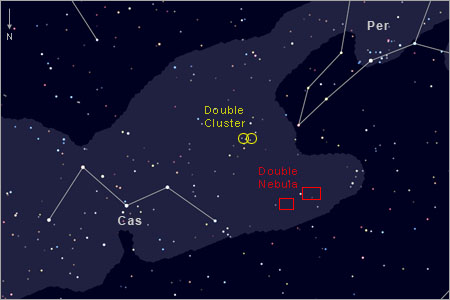|
Double Nebula and Double Cluster
Exposure Data
- Image Field of View:9.26° x 6.16°
- Camera Field of View: 14.82° x 9.92°
- Lens: Nikkor 85 mm f/1.4 AI-S
- Focal Length: 85 mm
- Focal Ratio: f/4
- Camera: Modified Canon Digital Rebel XS (1000D)
- ISO: 1600
- Exposure: 3 x 10 minutes (30 minutes total)
- Filter: Astronomik CLS
- SQM: 21.81
|
|
This star-rich area of sky lies in the Milky Way on the border of Cassiopeia and Perseus.
The Double Cluster in Perseus (NGC 884 and NGC 869) is at the upper left. On a clear night from a dark observing location, the Double Cluster can easily be seen with the unaided eye as a diffuse smudge of light forming a long equilateral triangle with epsilon and delta Cassiopeiae.
The Double Nebulae, at the lower right, are two large complexes of faint emission nebulosity in Cassiopeia. IC 1805, the Heart Nebula, is at lower left. LBN 667, the Soul Nebula, is at the upper right. Both are red hydrogen-alpha emission nebulae that are star forming regions.
North is to the upper left in the above image.

|
Double Cluster and Double Nebula
- Catalogs:
- NGC 869, h Persei, Cl 24, Mel 13
- NGC 884, Chi Persei, Cl 25, Mel 14
- LBN 667, IC 1848, SH 2-199
- IC 1805, Mel 15, Cr 26
- Common Name:Double Cluster, Double Nebula, Heart and Soul Nebulae
- Object Type: Open Clusters and Bright Nebulae
- Magnitude: --
- Size: 12° x 8°
- Constellation: Perseus and Cassiopeia
- Image Field Centered At:
- RA: 02h 33m 34s
- Dec: +60° 09' 26"
|
|
